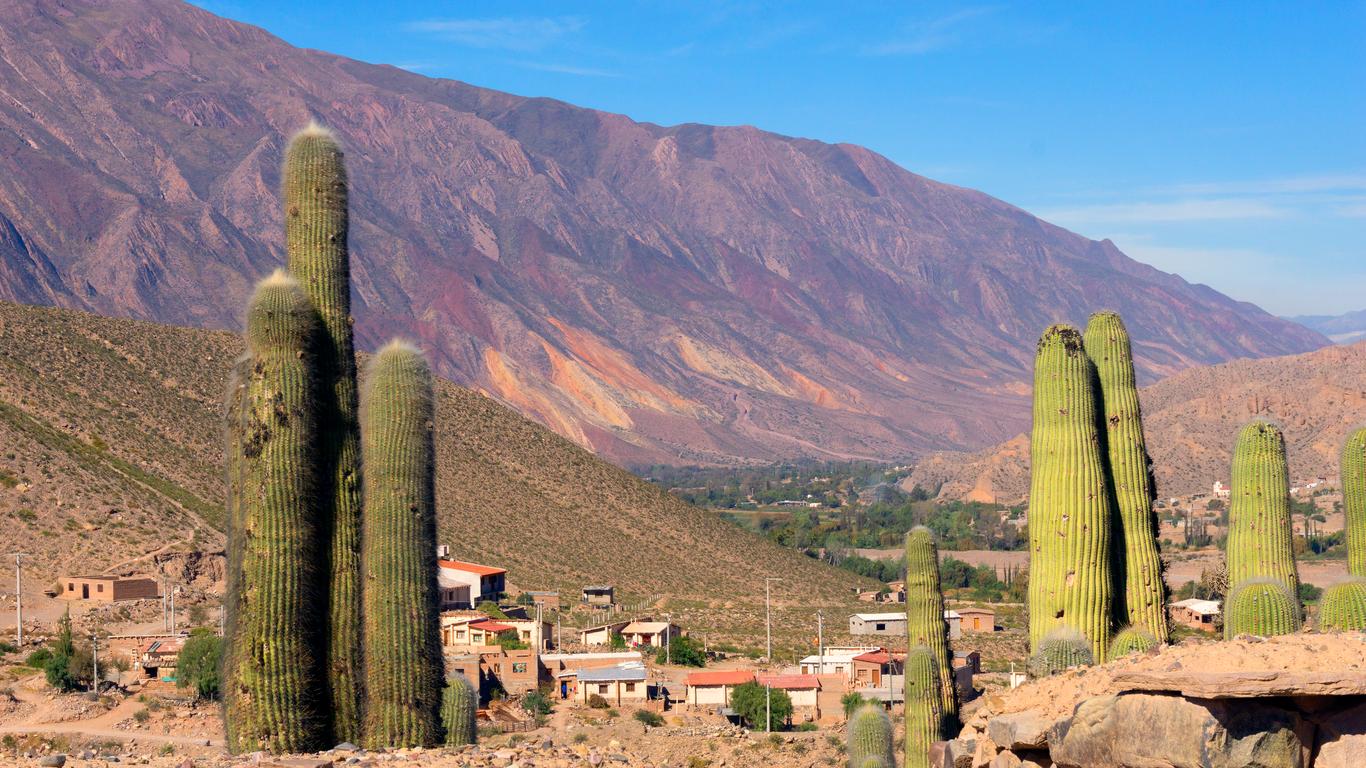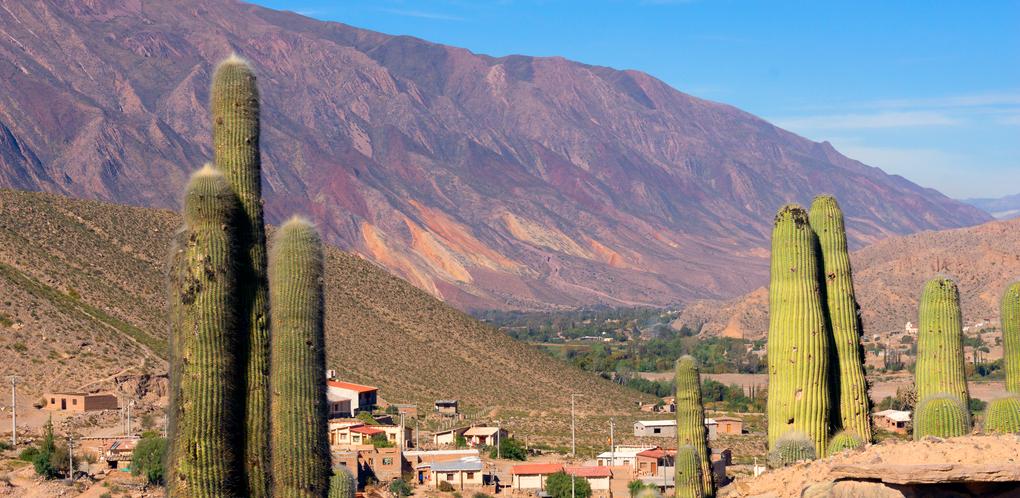
Tilcara travel guide
Tilcara Tourism | Tilcara Guide
You're Going to Love Tilcara
Whether you're coming for Carnaval, a day trip, or a longer stop, Tilcara will send you zooming back in time - far back, to when the land was untouched by Europeans. This UNESCO World Heritage Site draws many travelers for its perfect preservation of indigenous art and culture as well as archaeological finds.

Top 5 Reasons to Visit Tilcara
1. Visit La Isla
A beautiful pre-Columbian archaeological site, La Isla draws travelers from far and wide for its perfectly preserved history.
2. Check Out the Food and Textile Markets
As you're walking around town, you'll find plenty of local and informal food and textile kiosks that will grab your attention (and your wallet!).
3. Enter into the Botanic Garden of Heights
The gorgeous Garden of Heights miraculously features vegetation at an altitude of 8,202 feet above sea level!
4. Head to Pucara
Sitting at the top of a cliff is Pucara, the famous Omaguaca city, where you can also visit the local Archaeological Museum.
5. Take In Local History at the Museo Irureta
If you want to know more about the beautiful region you're visiting, why not survey local art to get a sense of the customs? This museum features art pieces by indigenous locals.
What to do in Tilcara
1. Unearth Pre-Columbian Culture
Dating back to the 12th century, the Pucará de Tilcara, a pre-Inca fortification overlooking the Quebrada de Humahuaca, was built by the Omaguaca tribe, who were distinguished warriors, farmers, weavers and potters. The pucará stretches over 15 acres and is comprised of windowless stone buildings, animal corrals and burial sites. Archaeologist Juan Bautista Ambrosetti began excavating the site in 1911 and uncovered 3,000 ancient artifacts. The site is still being explored today.
2. Discover Indigenous Artworks
Founded in 1968, the Museo Arqueológico Dr. Eduardo Casanova serves as a counterpart to the Pucará de Tilcara, exhibiting historic and cultural artifacts of the region. Spread out over five rooms, the museum showcases a pre-Hispanic collection of ceramics, deformed skulls, mummies and ritual masks dating back thousands of years. The museum also includes items recovered from the Tiahuanaco region of Bolivia and the Nazca and Moche region of Perú, as well as the Puna de Jujuy, Chimú and Inca regions, among others.
3. Explore Natural Wonders
Established in 1970, the Jardín Botánico de Altura strives to preserve the biodiversity of the Pucará de Tilcara. Stretching over 7.5 acres on the banks of the Huasamayo River, the gardens host a variety of workshops and activities related to the ecology, ecosystems and sustainability of the region. The grounds feature numerous seasonal plant species and endangered flora, as well as native trees and shrubs. The gardens also work diligently to educate the population on the greenhouse effect and climate change.
4. Modern Argentinian Art
Located in a mansion formerly owned by the Lozano Family, the Museo Irureta, founded in 1987, features twelve exhibition rooms with 222 contemporary creations inspired by the colorful indigenous culture of the region from renowned Argentinian artists, including Adolfo de Ferrari, Arturo Irureta, Aurelio Macchi, Hugo Irureta and Oscar Ferrarotti, among others. The museum endeavors to promote the artistic heritage and culture of northeastern Argentina. The museum, which features paintings, illustrations, ceramics and sculptures, also works with other museums to coordinate exchanges of artworks.
5. Heavenly Hillside Views
Set on the the Humahuaca Ravine, the Cementerio Nuestra Señora del Carmen, also known as the Cementerio Maimará, dates back to the early 20th century. This hillside necropolis features a striking array of sculptures, vaults and crosses in a variety of shapes and sizes that are painted in bright colors and decorated with dried flowers in keeping with local traditions. The cemetery can be accessed on foot and provides breathtaking panoramic views of the city below.
1. Unearth Pre-Columbian Culture
Dating back to the 12th century, the Pucará de Tilcara, a pre-Inca fortification overlooking the Quebrada de Humahuaca, was built by the Omaguaca tribe, who were distinguished warriors, farmers, weavers and potters. The pucará stretches over 15 acres and is comprised of windowless stone buildings, animal corrals and burial sites. Archaeologist Juan Bautista Ambrosetti began excavating the site in 1911 and uncovered 3,000 ancient artifacts. The site is still being explored today.
2. Discover Indigenous Artworks
Founded in 1968, the Museo Arqueológico Dr. Eduardo Casanova serves as a counterpart to the Pucará de Tilcara, exhibiting historic and cultural artifacts of the region. Spread out over five rooms, the museum showcases a pre-Hispanic collection of ceramics, deformed skulls, mummies and ritual masks dating back thousands of years. The museum also includes items recovered from the Tiahuanaco region of Bolivia and the Nazca and Moche region of Perú, as well as the Puna de Jujuy, Chimú and Inca regions, among others.
3. Explore Natural Wonders
Established in 1970, the Jardín Botánico de Altura strives to preserve the biodiversity of the Pucará de Tilcara. Stretching over 7.5 acres on the banks of the Huasamayo River, the gardens host a variety of workshops and activities related to the ecology, ecosystems and sustainability of the region. The grounds feature numerous seasonal plant species and endangered flora, as well as native trees and shrubs. The gardens also work diligently to educate the population on the greenhouse effect and climate change.
4. Modern Argentinian Art
Located in a mansion formerly owned by the Lozano Family, the Museo Irureta, founded in 1987, features twelve exhibition rooms with 222 contemporary creations inspired by the colorful indigenous culture of the region from renowned Argentinian artists, including Adolfo de Ferrari, Arturo Irureta, Aurelio Macchi, Hugo Irureta and Oscar Ferrarotti, among others. The museum endeavors to promote the artistic heritage and culture of northeastern Argentina. The museum, which features paintings, illustrations, ceramics and sculptures, also works with other museums to coordinate exchanges of artworks.
5. Heavenly Hillside Views
Set on the the Humahuaca Ravine, the Cementerio Nuestra Señora del Carmen, also known as the Cementerio Maimará, dates back to the early 20th century. This hillside necropolis features a striking array of sculptures, vaults and crosses in a variety of shapes and sizes that are painted in bright colors and decorated with dried flowers in keeping with local traditions. The cemetery can be accessed on foot and provides breathtaking panoramic views of the city below.
Where to Eat in Tilcara
There is no better place than El Nuevo Progreso 1917 for incredible local delicacies like lamb, goat cheese, pancakes with dulce de leche, and quinoa crepe. Expect to pay around AR$105 - AR$160.
When to visit Tilcara
Argentina, and Tilcara in particular, is beautiful year-round. Since Tilcara is in the north, plan to go during June to August, when average temperatures are usually 68.
How to Get to Tilcara
Plane
Travelers will land at the Jujuy International Airport (JUJ) in Tilcara. From here, use a bus or prepaid shared taxi to get to Tilcara. The journey is around 71 miles.
Car
To get from Humahuaca to Tilcara, use the RN9 and head south. It's a straight route.
Bus
Bus service gets into Tilcara from neighboring towns like Salta and Tumbaya. There are 10-12 services that run each day and fares start at $2.
Airlines serving Tilcara
Where to stay in Tilcara
Belgrano - this is a lively street where you can find hotels, hostels, restaurants, and the José A. Terry Museum packed with paintings of local life.
Popular Neighborhoods in Tilcara
Pucará de Tilcara - a pre-Hispanic hilltop fortification, this area lies just outside of town but is well worth a visit.
The Devil's Throat - watch out because this steep gorge calls for nerves of steel! Known locally as the La Garganta del Diablo, the sharp drops and tricky hikes reward you with scenic views.
Where to stay in popular areas of Tilcara
Most booked hotels in Tilcara
How to Get Around Tilcara
Public Transportation
Tilcara is small and everything in town is in close proximity so you can get by on foot.
Taxi
It's not easy to get a taxi in Tilcara, though you can certainly book a shared taxi to get to the city. Taxis in general cost AR$23.05 and it's AR$8.68 per mile thereafter.
Car
You can book cars from major companies like Hertz online or pick up any available rental at Jujuy International Airport when you arrive. Rentals start at AR$1,589 for a standard, compact 4-door car.
The Cost of Living in Tilcara
Shopping Streets
Besides more informal shops and markets set up in Tilcara, you can also shop at Mercado Municipal de Tilcara and Instituto de desarrollo indigena Tilcara.
Groceries and Other
A quart of milk costs AR$19.43 and a dozen eggs costs AR$30.15.
